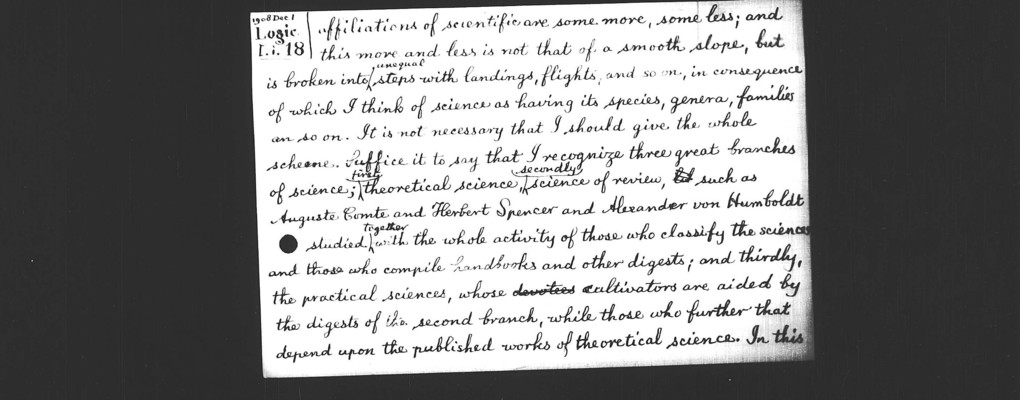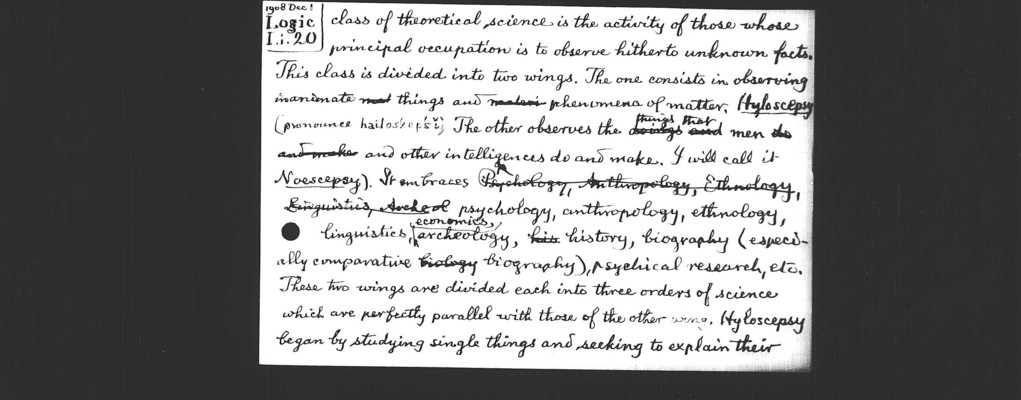Pages
115
1908 Dec 1 Logic I.i. 18
affiliations of scientific are some more, some less; and this more and less is not that of a smooth slope, but is broken into unequal steps with landings, fligts, and so on, in consequence of which I think of science as having its species, genera, families and so on. It is not necessary that I should give the whole scheme. Suffice it to say that I recognize three great branches of science; first, theoretical science, secondly science of review, such as Auguste Comte and Herbert Spencer and Alexander von Humboldt studied together with the whole activity of those who classify the sciences and those who compile handbooks and other digests; and thirdly, the practical sciences, whose cultivators are aided by the digests of the second branch, while those who further that depend upon the published works of theoretical science. In this
116
1908 Dec 1 Logic I.i. 19
last branch, I recognize two great clefts dividing the men of theoretical science, by their usual inability really to know the ways of working, except each those of the class to which he himself belongs. The first class is mathematics, whose devotees merely deduce the consequences of imaginary states of things, which they terme their hypotheses, without observing anything but their diagrams, mostly mental, some of them arrays of letters, others composed of lines, all of them embodying or instancing their hypotheses. The second class of theoretical science is philosophy, more exactly called, after Bentham, cenoscopy (κοινοσκόπια), whose cultivators inquire into categorical truth, but who make no special observations, but derive such results as they can from ordinary unscientific observations made by all men. The third
117
1908 Dec 1 Logic I.i. 20
class of theoretical science is the activity of those whose principal occupation is to observe hitherto unknown facts. This class is divided into two wings. The one consists in observing inanimate things and phenomena of matter, Hyloscepsy (pronounce hailoskep'si [??]). The other observes the things that men and other intelligences do and make. I will call it Noescepsy. It embraces psychology, anthropology, ethnology, linguistics, economics, archeology, history, biography (especially comparative biography), psychical research, etc. These two wings are divided each into three orders of science which are perfectly parallel with those of the other wing. Hyloscepsy began by studying single things and seeking to explain their
118
1908 Dec 1 Logic I.i. 21
origins. Astronomy and geognosy were the first sciences. The latter is now divided into geodesy (in the sense of the study of the form and size of the entire level surface of which the sea-level is a part, together with the explanation of its having that form), physical geography, hydrography and oceanography, the science of the tides, geology, etc. Such studies, which form the lowest order, are called descriptive sciences; but a better designation would be explanatory sciences; for mere description without explanation is the goal of an art rather than of a science. We must however within this third order of science distinguish a descriptive family of science and an explanatory family. As an explanatory science progresses it becomes acquainted with great numbers of more or less similar objects, and thus tends to pass into the second order, that of the Classificatory sciences. Each such science seeks, in the first place, to form a scheme of classification
119
1908 Dec 1 Logic I.i. 22
which shall truly represent the degrees, kinds, and ranks of importance of all the resemblances that it finds among the single objects of the general type that it studies. It also gives a common name to the single object of each of the groups that it recognizes. So far, its work is almost exactly like the first part of the work of the sciences of the third order. The chief difference is that a character may belong to a different proposition or a classificatory group in different degrees. Having carried out this descriptive work more or less thoroughly, making a strictly classificatory family of science, corresponding to the descriptive family of the third order, students of the second order become interested more and more in two new kinds of questions, giving rise to two new families of classificatory science. The first of these kinds of questions relates to how the objects of their study became separated into distinct classes




